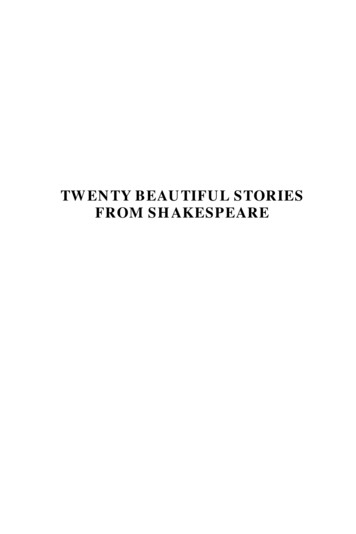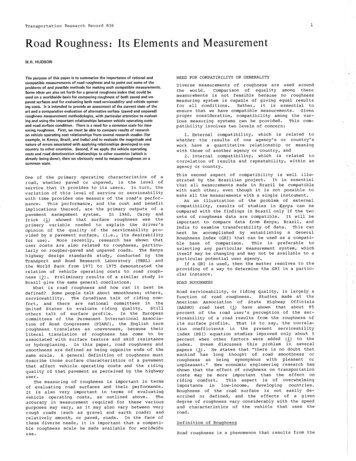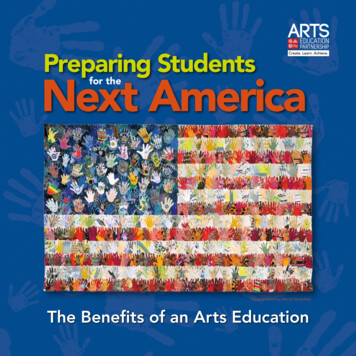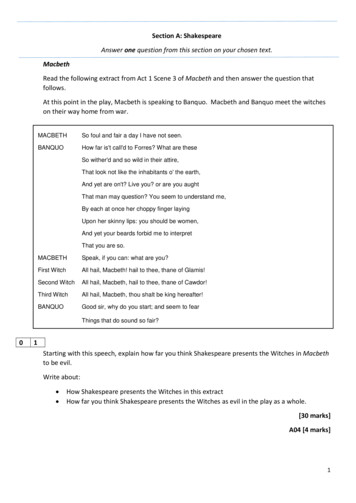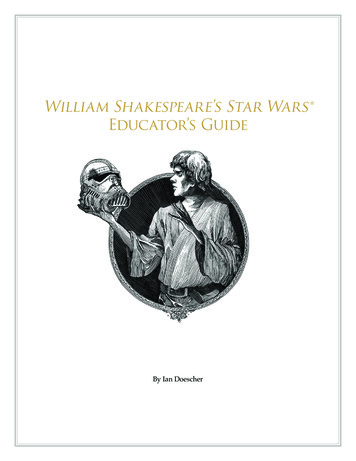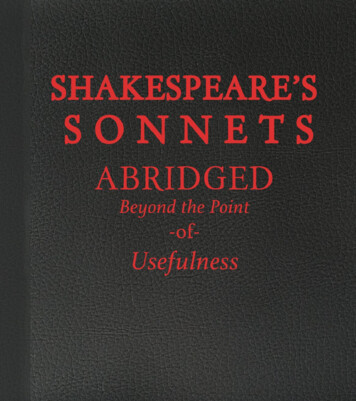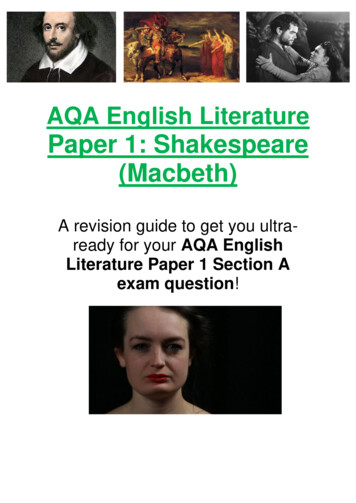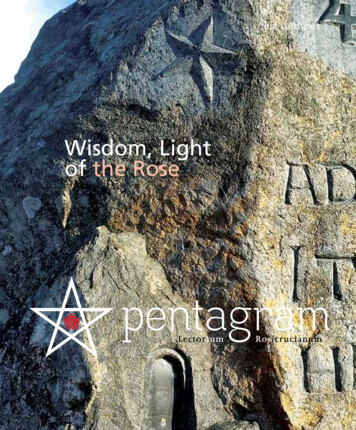
Transcription
2018number 2Wisdom, Lightof the RosepentagramLectoriumRosicrucianum
pentagram
Volume 41 2018 number 2pentagramBefore you lies an edition of Pentagram written as atribute to the rose as a universal symbol of unselfishlove which has been the highest ideal of any Rosicrucian and the focal point of his contemplation throughout the ages.We explore this symbol on the basis of her beauty andthe inspiration she has given the poets through theages, eliciting their most beautiful songs.What is it that allows the rose to exhibit her most delicate beauty, such as the silky texture of her petals, andto create a glimmer of hope in human hearts? Andwhy then her thorns that make it difficult to approachher beauty?Her perfect symmetry is hidden in the irregularity ofher leaves; she camouflages her essence in her rosefragrance. Her thorns are equally interesting, and thecross of her stem also points to timely needs and tothe great privilege of being human.O magic symbol of the unattainable! Sublime contradiction in a single flower! Perfect image of the strivinghuman!Only the noble bee which collects her nectar and theperson who dares to press her thorn to his heart areable to see the world of which she testifies.Meanwhile Logon, the new online magazine of theInternational School of the Golden Rosycross, hasmade its appearance. The editors of Pentagram, theprinted magazine, look forward to a dynamic interaction with this wonderful new initiative. Logon hasbeen designed to focus on ‘people who are lookingfor the meaning of life’. Pentagram offers, in bothshort as well as longer contributions, more extensivecoverage of subjects that are meaningful to seriousseekers. Contributors to both magazines are lookingahead to the blossoming of the roses—the new consciousness shining in human hearts as well as humanheads— precursors of a new era.Visit us at www.logon.media.Cover and aboveThe artists Serge Boyer & Fabienne Versé created‘L’Ère du Tchier de Borée’, (Boreas), which theyregarded as an initiation and inspirational labyrinth,in the rugged and high-altitude Regiona NaturalParc in the mountains of the Ardèche.1
Index4 The hymn of love61418272836394654Johann Valentin AndreaeEternal roseThe other reality of the roseThe Aquarian conspiracy revisitedWisdom, the Light of the RoseThe rose of reasonRose, o pure contradictionTo start all over againLecture Month of the Spirituality 2018Everything vibratesWhen I tried to think, staccatoInner monologue: Which awareness doesthe twenty-first century need?62Rumi, Ryokan, Yeats64Organ donation – the state of affairsThree poemsEssay74 The mystery around Francis Bacon76Jaap RuselerBooksWhat you see is yourselfColumnWorld images [3, 13, 45, 61]2Index
Tchier de BoréeWorld images‘As above, so below’ - The text of the Tabula Smaragdina, attributedto Hermes Trismegistus, carved into one of the modern ‘menhirs’, theseventy stones on the plateau of Tchier du Borée. The monumental workof art on the plateau just above Borée in the Ardèche forms one big3spiritual calendar of the universe. On the relatively flat surface, seventystones - many think of them as menhirs – form twelve triangles andseven squares: the geometric shapes that together determine the eightproportions of the divine ratios.
The hymn of loveFrom The Alchemical Wedding of CRCanno 1616, day VJohann Valentin AndreaeFilippino Filippino Lippi, Tobias and the Angel, ca. 1475-1480National Gallery of Art, Washington D.C.4InhoudThe hymn of love
INaught is better here on earththan matchless, noble love,whereby all sorrow flees us andwe’re made like God above.Therefore, let us praise the King,that all the sea thereof may ring.Now we shall ask; you answer.IIWhat unto Life has brought us?‘Twas Love.What unto Grace restored us?‘Twas Love.What was it gave us birth?‘Twas Love.How were we lost on earth?Without this Love.III What brings us forth and bears us?‘Tis Love.What succours and consoles us?‘Tis Love.What do we owe our parents?‘Tis Love.What gives them their forbearance?‘Tis Love.IV Through what power do we conquer?Through Love.How can we Love discover?Through Love.On what are good works founded?On Love.How are the two united?Through Love.VSo loudly we’ll sing;let our praises now ringin Love’s honour profound,that Love may aboundin our Lord, the Kingand his Consort the Queen,whose souls have gone hence,though their bodies are seen.VI As long as we live,to us God will givethe power His Love to convey,and in service aspire,in the flames of Love’s fire,the two to conjoin once again.VII Then shall this great sorrow beDeep joy eternally,And this holy happinessmany young hearts shall bless.5
There is no plant orflower that is more connected to the conceptof love than the rose.People often expresstheir deepest affectionfor someone with roses;it is the most belovedflower in love. In thehidden Christianity theheavenly rose standsfor the Sun-logos orChrist, Jacob Boehmespeaks in this connection of the Rose ofSharon, Goethe aboutthe mysterious rosesthat are wound aroundthe trunk of the cross.A walk through worldliterature, looking for the‘queen of flowers’.6Eternal rose
Eternal roseEvery afternoon Rainer MariaRilke, accompanied by alady-friend, went for a walkin the vicinity of his house,which was in Paris at thetime. In doing so, they passed a beggar-woman in the same place each time.The lady accompanying Rilke always puta coin in the thin outstretched hand, butRilke never had any money with him.One day he said, “We should give herheart something, and not just her hand.”A few days later he bought a beautifulred rose and put it in the beggar-woman’s hand. She stood up wordlessly,kissed Rilke’s hand, and left. It was notuntil a week later that she was back ather usual place. Rilke’s companion askedhim: “What would she have lived on allthat time?” After some thought, Rilkereplied, “On the rose.”The ‘queen of flowers’ can indeed havea special effect on a person. Traditionally, roses have attracted, fascinated andinspired humanity: its wonderful form,its colour, its delicious fragrance; evena blind person likes this flower for itsscent. Unconsciously or consciously, sheis the symbol of what moves us in thedeepest part of our heart.The most striking characteristic of therose is its petal arrangement: its petalsspiralling around a common centre. As asymbol of purity, of love, of high spirituality, the rose symbol is found amongmusicians, poets, visual artists, mystics,in some fairy tales, and above all in manygnostic groups; and since the event onGolgotha, also often in conjunction withthe cross.Already with the Manicheans, we findthe curious ‘tree of life’ graves, cruciform-shaped with a rose in the centre.Mani spoke of a ‘Cross of Light’, andin Ireland there is a monastery calledClonmacnoise where, against the wall,there is a stone pillar with a rose carvedin the centre of a cross. Clonmacnoisewas an old Christian centre for spirituality, founded in the year 546 by a certainCiarán; [See picture]. Further referenceto the rose is found in the canon of current Celtic-Irish music, which draws ona spiritual past, and in which is found asong called ‘Rosa Mystica.’Music of the roseThe rose is also found repeatedly in theworld of music.The Masonic opera Die Zauberflöte, the textof which was written by Schikaneder,has been excellently put to music by W.A. Mozart. The commentator Tjeu vanden Berk shows in a fascinating way thatthe text of this entire opera is inspired bythe Chymische Hochzeit CRC. (the AlchemicalWedding of CRC) He says: “When Pamina meets Tamino, just before the bigfire and water test, and they are allowedto hug each other for the first time, shesays about the arduous journey ahead ofthem:‘Everywhere I will beby your side.7
I myself will guide you.Love leads me!She may put obstacles on our path,but, like rose thorns,they will always be accompanied by roses.At the beginning of the last century, ErikSatie was interested in the phenomenonof the Rosycross in his own way. Hewrote a piano composition in three partsunder the name: ‘Sonneries de la Rose etCroix’.A bit later, the composer Gustav Mahler,who had an immense admiration forMozart, recorded in his second symphony a song called ‘Urlicht’:O roses red!Man is in dire need!Man is in the greatest agony![.]I am from God and want to return toGod!The good God will give me a little light,will lift me up into the Light, to theeternally blessed Life!(First and last stanza)The EastIn the third century of our era, Mani andthe Manicheans were specifically orientated towards Gnostic Christianity. Theysaw Jesus as both the only-begotten Sonof God, and at the same time as our trueinner self, the Light-I. Mani called Himthe highest Rose of the Father, meaning theperfect man.After centuries of activity in Eastern andNorth African countries, this GnosticChristian community disappeared fromview because of many kinds of opposition. However, this movement actuallycontinued as smaller Gnostic communities in the movements of the Pauliciansand the Bogomiles in Asia Minor, Bulgariaand the neighbouring Slavic countries,such as current Bosnia Herzegovinawhere you can still find many stone Stecci,or carved crosses, and crosses with roses.Then, in the twelfth century, connectionswere established between the Bogomilesand the Cathar communities, which weremainly situated in the Pyrenees. There,too, we find in this powerful landscapeand on the walls of the caves severalwondrous crosses and cross forms thattestify to their creation and use in thepast.From Mani’s Light Treasure we quote:Today we present You our Roseas a fruit-producing tree,that she may become an aureolethat You may place on our head.Further east, in Persia, India and Pakistan,in the twelfth and thirteenth centuries,we meet the famous Persian Sufi poetsHafiz and Rumi.Hafiz says: “That the world is created forLove, the roses and the nightingales bearwitness”, and another Persian poet fromthat time, Mahmoeb Shabistari called hispoetry collection The Hidden Rose Garden, ofwhich he says:I picked this bouquet of fragrant flowersfrom that gardenand I have called it ‘The hidden rose garden’.In there, the roses bloom from the secrets of the heartthat you have not heard before.The tongues of the lilies all sing withinand the eyes of the daffodils beholdeverything, far and near.Look silently at them all, with the eyes ofyour heart,till all your doubts melt away.The Indian Sufi master of the beginningof the last century, Hazrat Inayat Khan, whoduring his stay in the Netherlands pointed out the dunes of Katwijk as a suitableplace for a Sufi temple, says in poeticlanguage:8Eternal rose
That the world is created for Love,the roses and the nightingales bearwitness, HafizRose Valley, Bulgaria9
The rose offers me Your message of love.Let my heart bloom in Your love as theRose.ItalyDante Alighieri lived from 1265 to 1321.In the thirteenth century he wrote hisDivina Commedia, in which many gnosticelements can be found.The Commedia contains three stages: theInferno (hell), the Purgatorio (the purification mountain) and the Paradiso (thekingdom of heaven).In ‘The Universal Gnosis’, J. van Rijckenborgh indicates that Dante can be seenas the struggling microcosm awakenedby the call of the Gnosis; in that view,Virgilius is his dialectical self, the I-self,striving for relief, and Beatrice is the newsoul, the reborn man.In the storyline of Dante’s poem, theHeavenly Rose belongs to the Empyreum,the highest sphere of heaven that encloses all nine previous spheres. Dante,together with Beatrice, traverses these tenspheres or dimensions in the third stageof the story, to gain in theend the Candida Rosa (thewhite rose), the highest insight, the sight of the divinity, the visio Dei.Before this happens, he meetsBeatrice. Dante travels withVirgilius on a spiral waythrough the Inferno and thenthe Purgatorio, finally arrivingat the highest peak of thepurification mountain. ThereVirgilius stays behind andDante goes on to meet Beatrice, with whom he continues his journey (again spirally) through the nine heavenlyspheres to the all-enfoldingEmpyreum. On his way there,he first enters the sphere ofMars, where an immenseshining cross appears beforehis eyes. Along the beams ofthe cross, there is a constantcoming and going of soulsand angels.After finally seeing the Heavenly Rose (on whose petalsthe transfiguring souls successively rise to ever greaterdelights) he knows fromthat moment on it is of theessence to stay in the middleof the cosmic movement, asin the hub of a wheel, and hetestifies to this with the following words:When the smallest step already spanssuch a powerful Light, howwide then must spreadthe Light to the rose of vastinfinity?There is no near or far, nodown or up,because where God maintains10Eternal rose
the still presence of the centre,natural law will of itself stay close.The gold of this Rose of eternal life gradually opens and spreads a scent in whichBeatrice pulled me upward with her .The rose also was a symbol of love forthe Fedeli d’Amore (The Lieges of Love, orThe Faithful of Love), a group of troubadours that was active at the same time inItaly. Working from within the church,they tried to keep alive the universalesoteric Christianity in Italy, and at thesame time to effect a spiritual reform ofchurch and state. Besides the rose, theyalso displayed the cross and the eagle ontheir banner.They propagated chivalrous ideas (including courtly love) to improve society.From the old Arabic Sufi poetry forms,they adopted the image of the Beloved,“for the pure light of the One is toomuch to endure.” Ficino and other members of his Academy considered theirpoems to be “a supreme declaration oflove” in the sense of Plato. As a closedbrotherhood, they sought harmony between the human sides of their natureand their spiritual and mystical endeavours, unlike the mendicants, who triedto suppress the former. Their system ofinternal degrees in six stages correspondsto the six guides from Dante’s DivinaCommedia.In the Low Countries a few centurieslater, when Luther and Calvin establishedtheir authority, there was a similar groupactive, also working from within thechurch. That was in the sixteenth centuryand this organization, which operatedfrom the Amsterdam chamber of rhetoricd’Eglantier (the wild rose), called itself“De Broeders in Liefde Bloeyende” (“The Brothers Blooming in Love”). This was at thetime of Dirck (Theodore) Coomhert, andafter he had received a publication banfrom the Haarlem authorities, his friendSpieghel invited him to become a member of these Brothers. Other memberswere playwrights and poets such as Vondel, Hooft and Bredero.This group did not call themselves Rosicrucians, but what is in a name? – evidencesuggests they were. For example, witnesstheir emblem showing a seven-petalledred rose with a thorny cross underneath,around which both bees and spiders areactive - the exact same emblem that weencounter a bit later with the EnglishmanRobert Fludd, who openly called himselfRosicrucian. He may well have taken overthis emblem from the Brothers Bloomingin Love.In southern Germany, Tobias Hess, withhis kindred spirits such as J. V. Andrea,was also aware of the existence of thisAmsterdam group. He admired their universal view of Christianity, and a numberof typical Rosicrucian elements matchedtheir thoughts. It is possible that therhetoricians influenced the works of theTübinger Circle, and it pleased them thattheir viewpoint was being propagated,not only literally, but also in the form oftheatre and allegories. After all, it was atime when all these figures of spiritualnobility were in contact with each otherinternationally: they often knew eachother’s works, and figures such as Joachim Morsius visited them and so keptthe connections alive. For all of them thesymbolism of the rose and the cross wasprofound, and well known. In this sense,the conclusion is justified that behindthe appearance of esoteric groups or individuals such as Dante, the Order of theRosycross was, and remains, an invisiblesource of inspiration throughout theages.Christ, the Solar Logos, is also denotedas the Heavenly Rose and the seventeenth-century poet and engraver JanLuyken, who was inspired by Jacob Boe-11Her Eyes are with Her Thoughts andThey are Far Away, Lourens AlmaTadema, 1897
The desert rose is also a striking symbol: it can remainclosed for years, seemingly lifeless, but once the rainwater comes to her, it blooms beautifully. It is the Roseof Jericho, and it symbolizes resurrection and eternal life.hme, called Christ the Rose of Sharon.A few centuries later, Johann Wolfgang vonGoethe clearly shows that he, too was inspired by the 17th century Rosicrucians.Witness his long poem “Those Secrets.”We quote some striking couplets.In verse 6 and 7, the pilgrim Marcushurries to a fine building that scintillatesahead of him, and where, while he hasto wait at the closed gate, he sees a puzzling image.Couplet 8 then reads as follows:The sign he sees erected here on highThat brings consoling hope to all mankind,Which many thousands pledged their lives to shield,To which in fervour prayed the human mind,That has destroyed the bitter powers of death,On victors’ banners fluttered in the wind:A stream of comfort permeates his being,He sees the cross and bows his head in seeing.Couplet 9He feels anew the faith of all on earth,The power of salvation streaming thence;But as he looks, he feels his very soulPervaded by a new and unknown sense:Who added to the cross the wreath of roses?It is entwined by blooming, clusters dense,Profusely spreading just as though they couldEndow with softness e’en the rigid wood.In verse 33 and 34, Marcus is led to aroom with a mighty cross-vault risinghigh, and along the walls he sees thirteenseats.Then verse 35 reads:Above each chair was hung a special shield,Thirteen in all the number he espied.They seemed to be important, purposeful,No boast of ancestors in shallow pride.And brother Mark, with longing all aglow,Desired to learn what secret they did hide:Lo, in the middle one the mystic sign,The cross which clustring roses do entwine.The Portuguese poet Fernando Pessoa wasalso fascinated by the Rosicrucian writings, as evidenced by a fragment fromone of his poems, freely translated fromPortuguese:. but if the soul espies an error in itself,which is in essence only shadow,she at the other side will see The Wordthat is The Light in this world ‘s meadow,Both human and anointed, and then overawed:The perfect Rose, crucified in God.In Bulgaria there is a region around thecity of Kazanlak, where two river valleys converge to form the beautiful RoseValley, the Rozova dolina. The valley hasbeen famous for centuries for its rose oilessence industry with close to fifty percent of all rose oil in the world extractedthere. Every year festivals are celebratedwith roses and rose oil, and the peopleknow the symbolic power of this flowerof flowers.Peter Deunov, the patriarch of the BulgarianWhite Brotherhood once said: “One of themost important events in the cosmos is the burstingof the flower bud of the soul; all higher beings of the12Divine world are looking forward tothe flourishing of the human soul.”The beginning of that processof blooming is a moment ofconsciousness, as we read inthe ‘Commemorative Volume dedicated to Catharose de Petri: “Whenour consciousness experiences thisdistress and sighs for liberation, andits cry vibrates out into the unknown,the Rose receives, as it were, a magnetic shock, which causes it to sendthe echo of the soul’s cry of distress tothe sternum, as a kind of reflex reaction. In this way, the power of theRose effects an opening in the heartsanctuary .It is on this beginningthat every child of man needs tobuild ”In the progress of this process, as Antonin Gadal oncewrote, “The black cross, signof sin, penance and death,will change into the whitecross of Light, the radiantsign of the Resurrection,from which the roses ofeternal love descend, livingroses that are fragrant like thebreath of angels.”And another faithful brotherof the Rosycross once finished his speech with:‘One will ask: does Love havea fragrance? Yes, it is the fragrance of Roses! “Eternal rose
Tchier de BoréeWorld imagesEvery stone on the plateau of Tchier du Borée is numbered andsculpted, and each stone conveys its own message. The visitorrecognizes the symbols that have been depicted according tohis insight and knowledge of the cosmic, historical and mythological references they contain. When you enter the circularboundary, you are thrown back and forth between surprise andadmiration.‘We want to help people recognize these and similar places thatare so full of history, and at the same time we try to connectthem with the world of the imaginary - a world as interesting asthat of the intellect’, according to the artists.13
The Other Reality of theFragrance?Maybe that is where it starts.It’s possible, why not?In Rennes, Brittany, France, onefinds the largest rose garden inEurope, laid out in concentric circlesegments.It s an extraordinary rose experience to spend some time there;the smells are overwhelming, eventhough there are varieties of rosesthat have hardly any perfume.Certainly, sniffing and even smelling the central flower can be agood start for ‘the rose reality’.No matter how real it is for thesense of smell and for the brain,for many the beginning is like adream, often a dream of Venus,of a symbol of love.14The Other Reality of the Rose
Rose Sony World Photography Awards ‘Lonely Tree’. Tom Jacobi (Germany) in the category Professional Landscape15
Is this the reason why Paul Biegelintroduces the reality of the rosein his story Sleeping Beauty ,from the collection ‘The LastStories of the Century’, in adream environment in which the hero,sailor Gerrit, has found himself. Via animmense hall with a tiled floor and apyramid-like ceiling, he enters a stonecorridor, leading on to a room.A room full of people. But no onespeaks, no one moves. Is there no life inthat room, with all those people?her beauty, as a result of which he is fined. But that s another story.So, suddenly life has sprung up into the rose story, through the love ofGerrit, by the fast beating of his heart, by giving in to the attraction ofbeauty. This is an important stage in exploring the reality of the rose:through the desire for her, life arises - and what kind of life it is!Because those present in the castle hall now discover Gerrit, they discover in their own turn the principle that becomes aware of the rose reality!And they almost throw themselves en masse upon him.He steps backwards, tries to flee. But they grab him by the arms, by hisSilencingAn important aspect of that first exploration of the reality of the rose is that ofthe static, the absolutely silent situation.Does it remain that way? Does the thereality of the rose, which is so close,remain so silent, so without life?LifeIn the story of Paul Biegel, Venus strikesonce again: Gerrit sees a young womanin the company, indescribably beautiful,so beautiful that his sailor’s heart startsto beat faster. But she, too, does notmove, does not speak - and the tableauvivant becomes something spooky,because of the deathly silence and therigidity in which everyone sits.Gerrit slowly walks towards the feminine beauty and wants to put a handon her shoulder. And then it happens:suddenly the room is full of buzzingvoices, cheerful laughter and talk. Theother reality of the rose suddenly becomes full of life, through the focus onbeauty, actually through the infatuationof the hero.In the Alchemical Wedding of Christian Rosycross we see a similar scene,when the curious researcher from theseventeenth century, Christian Rosycross,beholds the naked figure of Venus in all16The Other Reality of the Rose
hands, shout unintelligible things, pullhim to the table, push him into a chair,put a plate in front of him, pour a glassof wine for him, tie a napkin around hisneck and call: ‘Nam zili, nam gli, namvolozia pinex!’No, Gerrit does not understand thiseither, but he understands that he iswelcome, even very welcome. They areapparently looking forward to his presence.It is a next step in exploring the rosereality. Undergoing life, love and joy but. in an unintelligible language!The nobility of the other realm in you iswell disposed towards you, but does notspeak your language yet. Or you don tspeak hers. Yet it is special if you alreadyhear the inner voice, experience theworking of the rose, if you undergo itsvibration: the principle of knowing theother reality has already been broughtto life.How is this going to continue? Becauseundergoing this life and this joy in anunintelligible language surely can t bethe end of the development.ThornActually, the ability of the self startsafterwards; the self-surrender that alsoOscar Wilde describes in a story. Wildegoes so far, that the thorn of the roseitself must be pressed into the heart: giving life to the rose is a crucifixion. Onewill, figuratively speaking, be preparedto let the thorn open one’s own heart.And in another story by Paul Biegel, The Last Rose , he expresses it as follows: the dedication to the rose becomesso great that one is willing to give hislife for it – in order to learn to understand the words and meaning of thelanguage of that other reality.This is perhaps most unrealistic for understanding the other reality:that one is willing to allow another reality for the heart, or at least thewillingness to purify the heart. Only then will the alienating effect of thenew heart-environment reveal its incomprehensibility and we will learnthe language of love, which is the same as the language of the rose. Andwhat seemed to be a crucifixion, then becomes an alchemical feast. Thesailor finally manages to kiss the beauty, after which she says in his ownlanguage: ‘Are you there? I left you alone, you were sleeping so soundly! Biegel calls the other reality ‘enchantment’. That is what happens toGerrit: Instead of breaking the spell with his kiss, he himself had fallenunder the spell and had become one of them. That is why he can understand her now.Outside of our time and space, as the story indicates, is the location ofthe castle. It can t be determined geographically and time there is alsodifferent. But sailor Gerrit lives on in that reality, according to the story. One day every year he walks with his beloved princess through themagnificence of fields and woods [.] and flower beds full of roses - andone night he sleeps next to his princess in that wonderful castle the location of which nobody knows.’Expectations,Lourens Alma Tadema, 188517
The Aquarius conspiracyrevisited. A repositioning.The well-known Dutch novelist Hella S. Haasse begins her modern work’ De Meester van de Neerdaling (The Master of theDescent) (1973) with the following introduction:‘Satan is not just called the ruler of this world – in fact, that’s exactly what he is. He rules this world. We will not conquer an enemyif we try to look beyond its danger.’The first part of the novel is called ‘De duvel en zijn moer’ (Thedevil and his mother) and is characterised by an exciting game oftruth and imagination. It becomes especially impassioned when itis revealed how an existing hierarchical order abuses the energyof young boys for self-serving so called ‘spiritual’ goals. It is for thereader to judge whether these goals are indeed truly spiritual.Since the release of MarylinFerguson’s famous book TheAquarius Conspiracy almostforty years ago, the basicvalues of the astrological eraof Aquarius have been diluted under theinfluence of an aggressive economic culture. Nothing much has been realised ofthe flower power impulse of the sixtiesand seventies, for this impulse could notbe commercialised.On the contrary, values such as these aremore likely to turn into their oppositesin this dialectical world. Ferguson’s aimto make a contribution to ‘personal andsocietal transformation in the eighties’ failed during that decade, a decadewhich was critical to social transformation potential. On the contrary, theeighties saw the beginning of a strengthened and deepened free market economyfollowing a neo-liberal discipline (Reagan-Thatcher) that does not show theleast Aquarian element. Thereby, socially,18 Perlaki MartónThe Aquarius conspiracy revisited. A repositioning
19
“the dawning of the Age of Aquarius”was darkened and eventually evaporated.At the same time, the subject of conspiracies and their likelihood has hadthe same fate as the idealistic Aquariusvalues, especially from a cultural-social-philosophical perspective. It issocially unacceptable to ‘believe’ inconspiracies. It is seen as a sign of immaturity to see reality from the perspective of a conspiracy, even thoughthe evidence may be found all aroundus. This is because the foundation of itis seen as a craving for a simplistic andstraightforward explanatory model ofreality, which stems from fear. It consists of a black and white thinking aboutforces and powers that are experiencedin reality. This sort of thinking is oftenseen as immature. ‘If it were that simple ’ is what people respond. Moreover, our knowledge about the complexityof global processes makes us questionsimple theories that are discrediting oroffending certain population groups,classes or income categories. Anotherimportant reason is that the ultimate fuelfor conspiracy theories, the dichotomyof the cold war, has dried up since theend of that war around 1989.InterpretationAn important reason to ignore conspiracy theories stems from the mathematicalfield of science, which rejects proof bycontradiction: you could try to fit signsand situations from reality into yourown theoretical model, but this canvery easily lead to self-deception. Proofby contradiction goes against ‘commonsense’, especially when it comes to conspiracy theories about the unseen powers, which are theories that talk
BOOKS The mystery around Francis Bacon Was he indeed Shakespeare? Did he infl uence the thinking of the Rosicrucians? pentagram Lector ium Rosicrucianum 2018 numbe


